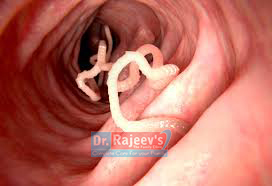


A pinworm infection is one of the most common types of human intestinal worm infections. Pinworms are tiny, narrow worms. They’re white in color and less than a half-inch long. Pinworm infections are also known as enterobiasis or oxyuriasis.
They’re the most common type of human worm infection in the United States, according to the Centers for Disease Control and Prevention (CDC).
Pinworm infections can spread easily. They’re most common in children between the ages of 5 and 10, people who live in institutions, and those who have regular, close contact with individuals in these groups.
An effective treatment for pinworm infections is medication, though reinfection is possible. Serious complications and long-term health effects are rare.
Some individuals with pinworm infections may not experience any symptoms. However, you may suspect that you or your child has a pinworm infection if you notice:

Symptoms of pinworm infection may include:
Pinworms often cause no symptoms.
Pinworms infections are highly contagious. You become infected with pinworms by unintentionally ingesting or inhaling pinworm eggs.
These eggs are usually deposited onto a surface or object by a person who’s been infected. The cycle of infection begins with the ingestion of these microscopic eggs.
Once the eggs enter your body, they remain in the intestine until they hatch and mature. As adults, the female pinworms move into the colon and exit the body through the anus at night.
Female pinworms lay eggs in the folds of skin around the anus and then return to the colon. The presence of these eggs often causes anal itching and irritation.
When a person scratches the affected area, the pinworm eggs transfer to the fingers. The eggs can survive for several hours on your hands.
If a person who’s been infected touches household objects like bedding, clothing, toilet seats, or toys, the eggs will transfer to these objects. Pinworm eggs can survive on these contaminated surfaces for up to three weeks.
Children transfer pinworm eggs easily because they may put infected toys or other objects directly into their mouths. The eggs can also transfer from contaminated fingers directly to food or liquids.
While uncommon, it’s also possible for adults to inhale airborne eggs when shaking contaminated bedding, towels, or clothing.
Pinworms generally live for up to 13 weeks. Scratching an affected area can lead to unintentional ingestion, which can lead to reinfection and a restart of the entire pinworm life process.
Sometimes, eggs on the anus can hatch and the pinworm larvae can reinfect the intestine that they came from. This can cause an infection to continue indefinitely if it’s not treated.
CINA - Useful for worm troubles in children. with g Grinding of teeth during sleep The child is irritable. .Anal or vaginal itching due to pin worms.There is cramping, colic pain in the abdomen due to worms. Another symptom is canine hunger or loss of appetite due to worms .Cina is a good remedy for convulsions from worm troubles.
SANTONINE-Useful for round and pin worms with itching in nose, restless sleep and twitching of muscles.
ABROTANUM -Useful for round worms with marked emaciation . child is ill-humored and irritable.
CALADIUM -Useful for worms with itching in vagina.The worms travel over the perineum and get into the vagina in little girls with tendency to excite masturbation.e.t.c
RL52